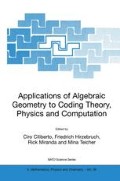Abstract
To decompose solution sets of polynomial systems into irreducible components, homotopy continuation methods generate the action of a natural monodromy group which partially classifies generic points onto their respective irreducible components. As illustrated by the performance on several test examples, this new method achieves a great increase in speed and accuracy, as well as improved numerical conditioning of the multivariate interpolation problem.
The first author thanks the Duncan Chair of the University of Notre Dame for its support.
Access this chapter
Tax calculation will be finalised at checkout
Purchases are for personal use only
Preview
Unable to display preview. Download preview PDF.
References
Björck, G. (1985) Functions of modulus one on Z pb whose Fourier transforms have constant modulus, in Proceedings of the Alfred Haar Memorial Conference, Budapest, volume 49 of Colloquia Mathematica Societatis Jânos Bolyai, pp. 193–197.
Björck, G. (1989) Functions of modulus one on Z n whose Fourier transforms have constant modulus, and “cyclic n-roots”, in J.S. Byrnes and J.F. Byrnes (eds.), Recent Advances in Fourier Analysis and its Applications, volume 315 of NATO Adv. Sci. Inst. Ser C: Math. Phys. Sci., Kluwer, pp. 131–140.
Björck, G., and Fröberg, R. (1991) A faster way to count the solutions of inhomogeneous systems of algebraic equations, with applications to cyclic n-roots, J. Symbolic Computation 12(3), 329–336.
Björck, G., and Fröberg, R. (1994) Methods to “divide out” certain solutions from systems of algebraic equations, applied to find all cyclic 8-roots, in M. Gyllenberg and L.E. Persson (eds.), Analysis, Algebra and Computers in Math, research, volume 564 of Lecture Notes in Applied Mathematics, Marcel Dekker, pp. 57–70.
Davenport, J. (1987) Looking at a set of equations, Technical report 87-06, Bath Computer Science.
Diaconis, P., Eisenbud, D., and Sturmfels, B. (1998) Lattice Walks and Primary Decomposition, in B.E. Sagan and R.P. Stanley (eds.), Mathematical Essays in Honor of Gian-Carlo Rota, volume 161 of Progress in Mathematics, Birkhäuser, pp. 173–193.
Dietmaier, P. (1998) The Stewart-Gough platform of general geometry can have 40 real postures, in J. Lenarcic and M.L. Husty (eds.), Advances in Robot Kinematics: Analysis and Control, Kluwer Academic Publishers, Dordrecht, pp. 1–10.
Emiris, I.Z. (1994) Sparse Elimination and Applications in Kinematics, PhD thesis, Computer Science Division, Dept. of Electrical Engineering and Computer Science, University of California, Berkeley.
Emiris, I.Z., and Canny, J.F. (1995) Efficient incremental algorithms for the sparse resultant and the mixed volume, J. Symbolic Computation 20(2), 117–149. Software available at http://www.inria.fr/saga/emiris/saga/emiris.
Faugère, J.C. (1999) A new efficient algorithm for computing Gröbner bases (F 4), Journal of Pure and Applied Algebra 139 (1–3), 61–88. Proceedings of MEGA′98, 22–27 June 1998, Saint-Malo, France.
Haagerup, U. (1996) Orthogonal maximal abelian *-algebras of the n × n matrices and cyclic n-roots. in Operator Algebras and Quantum Field Theory, International Press, Cambridge, MA, pp. 296–322.
Hosten, S., and Shapiro, J. (2000) Primary Decomposition of Lattice Basis Ideals, Journal of Symbolic Computation 29(4&5), 625–639.
Husty, M.L. (1996) An algorithm for solving the direct kinematics of general Stewart-Gough Platforms, Mech. Mach. Theory 31(4), 365–380.
Husty, M.L., and Karger, A. (2000) Self-motions of GriflRs-Duffy type parallel manipulators, Proc. 2000 IEEE Int. Conf. Robotics and Automation, CDROM, 24-28 April 2000, San Francisco, CA.
Isaacson, E., and Keller, H.B. (1994) Analysis of Numerical Methods, Dover Publications.
Li, T.Y., and Li, X. (2001) Finding mixed cells in the mixed volume computation, Found. Comput. Math. 1(2), 161–181. Software available at http://www.math.msu.edurii.edurii.
Möller, H.M. (1998) Gröbner bases and numerical analysis, in B. Buchberger and F. Winkler (eds.), Gröbner Bases and Applications, volume 251 of London Mathematical Lecture Note Series, Cambridge University Press, pp. 159–178.
Raghavan, M. (1993) The Stewart platform of general geometry has 40 configurations, ASME J. Mech. Design 115, 277–282.
Sommese, A.J., and Verscheide, J. (2000) Numerical homotopies to compute generic points on positive dimensional algebraic sets, Journal of Complexity 16(3), 572–602.
Sommese, A.J., Verscheide, J., and Wampler, C.W. (2001a) Numerical decomposition of the solution sets of polynomial systems into irreducible components, S/AM J. Nutner. Anal. 38(6), 2022–2046.
Sommese, A.J., Verscheide, J., and Wampler, C.W. (2001b) Numerical irreducible decomposition using projections from points on the components, accepted by Contemporary Mathematics, available at http://www.nd.edursommese/sommese and http://www.math.uic.edurjan.edurjan.
Sommese, A.J., and Wampler, C.W. (1995) Numerical algebraic geometry, in J. Renegar, M. Shub and S. Smale (eds.), The Mathematics of Numerical Analysis, Proceedings of the AMS-SIAM Summer Seminar in Applied Mathematics, July 1 7-August 11, 1995, Park City, Utah, volume 32 of Lectures in Applied Mathematics, pp. 749–763.
Verscheide, J. (1999) Algorithm 795: PHCpack: A general-purpose solver for polynomial systerns by homotopy continuation, ACM Transactions on Mathematical Software 25(2), 251–276. Software available at http://www.math.uic.edu/~jan.edu/~jan.
Wampler, C.W. (1996) Forward displacement analysis of general six-in-parallel SPS (Stewart) platform manipulators using soma coordinates, Mech. Mach. Theory 31(3), 331–337.
Author information
Authors and Affiliations
Editor information
Editors and Affiliations
Rights and permissions
Copyright information
© 2001 Springer Science+Business Media Dordrecht
About this chapter
Cite this chapter
Sommese, A.J., Verschelde, J., Wampler, C.W. (2001). Using Monodromy to Decompose Solution Sets of Polynomial Systems into Irreducible Components. In: Ciliberto, C., Hirzebruch, F., Miranda, R., Teicher, M. (eds) Applications of Algebraic Geometry to Coding Theory, Physics and Computation. NATO Science Series, vol 36. Springer, Dordrecht. https://doi.org/10.1007/978-94-010-1011-5_16
Download citation
DOI: https://doi.org/10.1007/978-94-010-1011-5_16
Publisher Name: Springer, Dordrecht
Print ISBN: 978-1-4020-0005-8
Online ISBN: 978-94-010-1011-5
eBook Packages: Springer Book Archive

